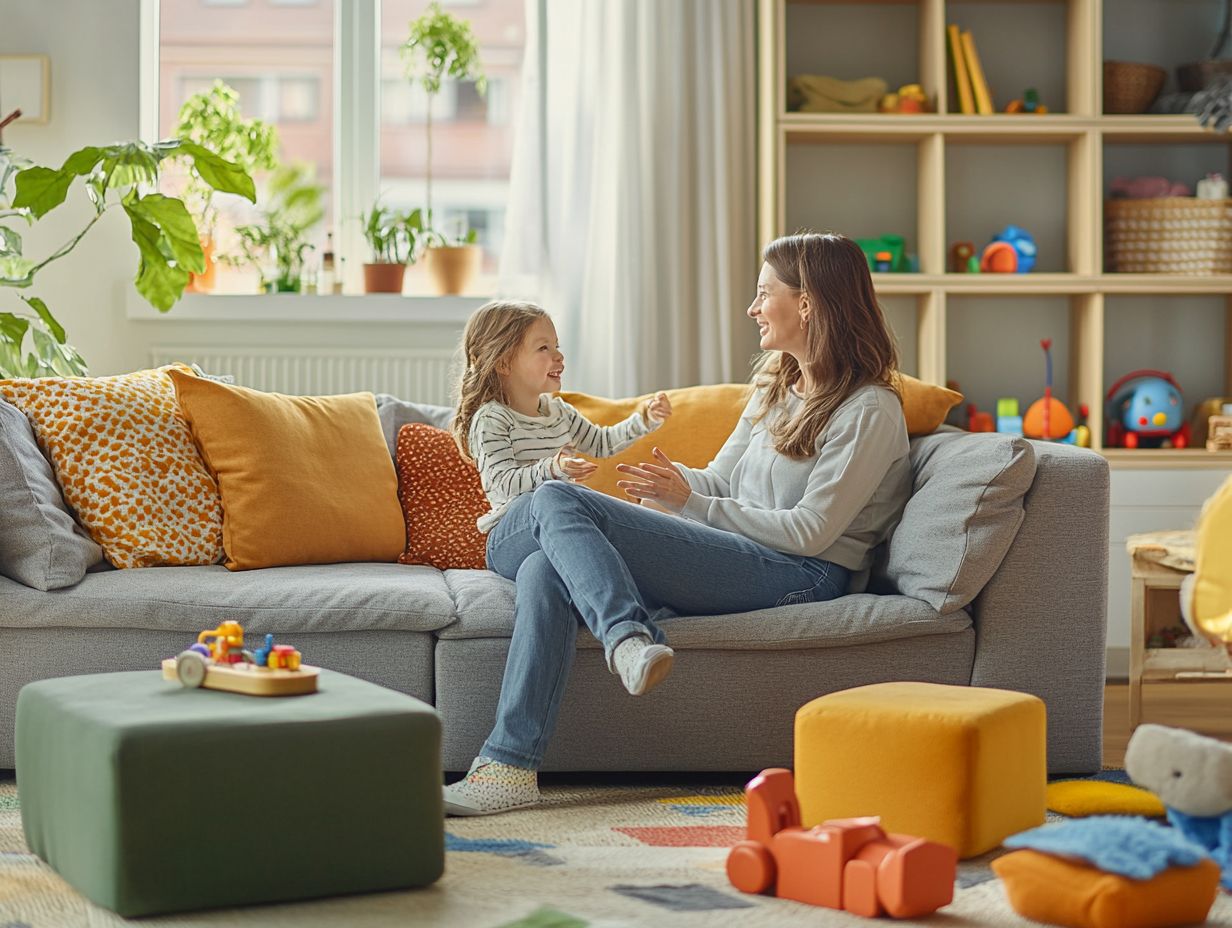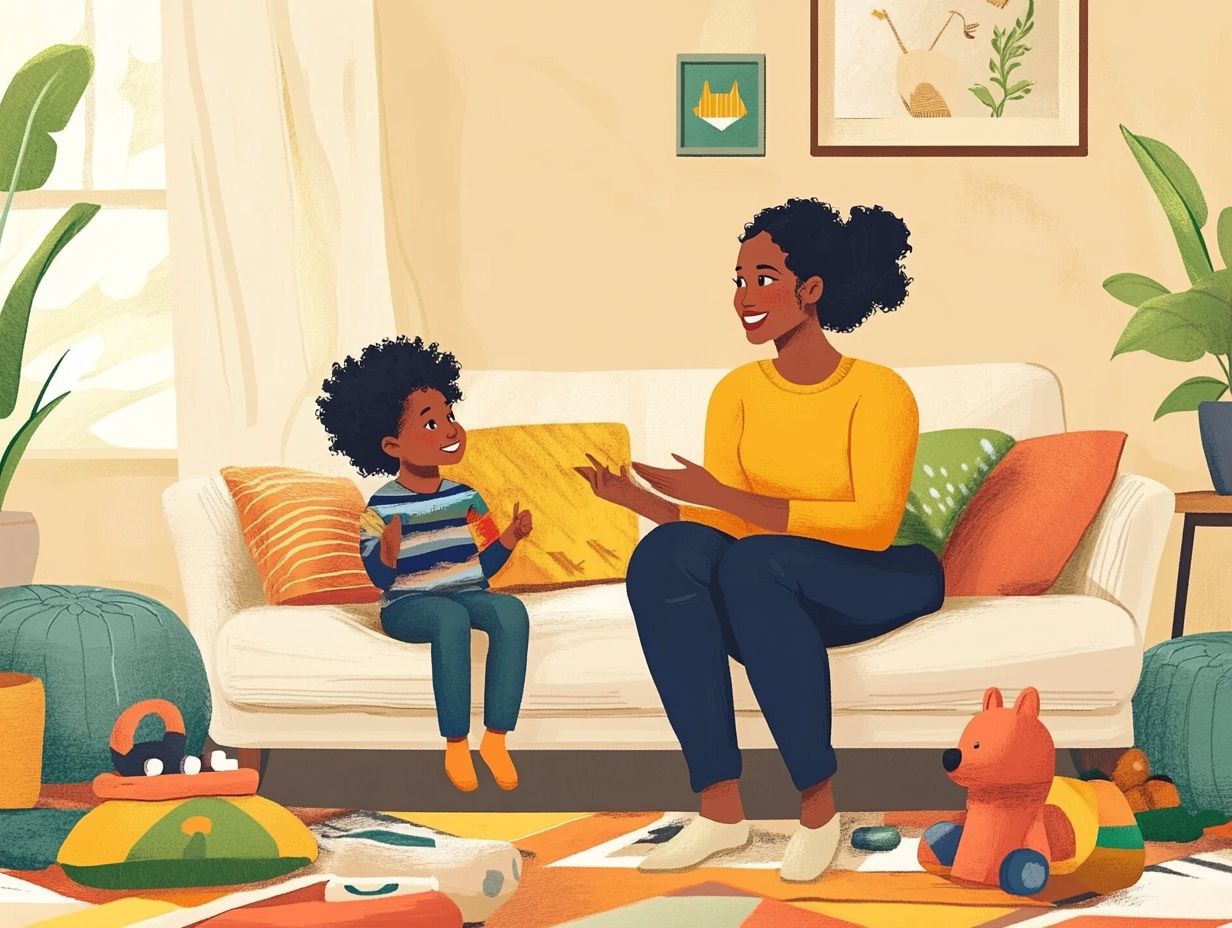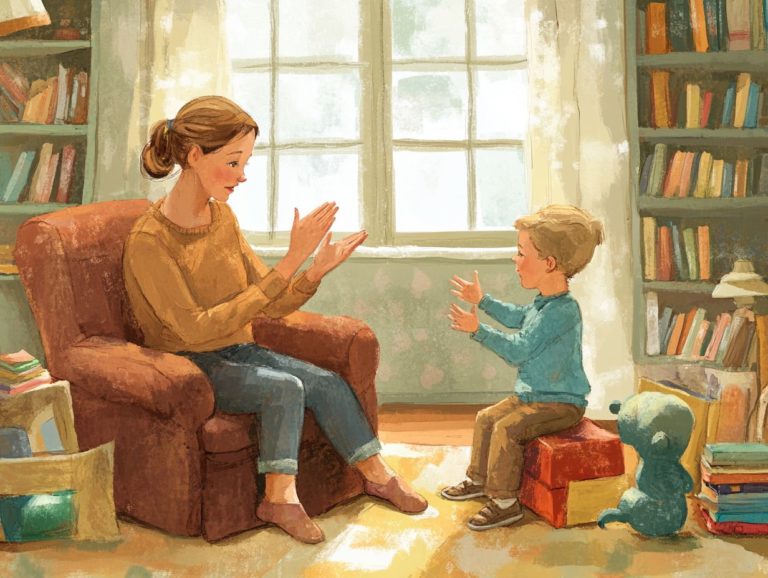How to Foster Open Dialogue with Your Child
Open dialogue serves as a powerful tool in nurturing healthy relationships, particularly with children. It fosters trust, encourages genuine expression, and builds strong emotional connections that are essential for their development. This form of open communication is crucial for child development and establishing a solid parent-child bond.
However, barriers such as time constraints, fear of judgment, and differing communication styles may hinder these vital conversations, impacting both healthy communication and emotional expression.
This discussion will delve into the significance of open dialogue, exploring its many benefits and offering insights on how to cultivate an inviting environment for meaningful exchanges. You ll also discover practical parenting tips for initiating open conversations with your child, ensuring they feel truly heard and valued.
Contents
- Key Takeaways:
- Why is Open Dialogue Important?
- What are the Barriers to Open Dialogue?
- How to Create an Environment for Open Dialogue?
- 1. Active Listening
- 2. Non-judgmental Attitude
- 3. Empathy and Understanding
- Conclusion
- 4. Encouraging Expression
- How to Initiate Open Dialogue with Your Child?
- Create a Safe Space
- Be Patient and Persistent
- Frequently Asked Questions
- 1. How can I start fostering open dialogue with my child?
- 2. What are some strategies for encouraging open communication with my child?
- 3. How can I establish trust with my child to foster open dialogue?
- 4. What should I do if my child seems hesitant to open up to me?
- 5. How can I handle difficult or sensitive topics during open dialogue with my child?
- 6. What are some benefits of fostering open dialogue with my child?
Key Takeaways:

- Act now to foster open dialogue with your child by actively listening, being non-judgmental, empathetic, and encouraging their expression. This helps establish communication and enhances emotional intelligence.
- Create a safe space for open dialogue by asking open-ended questions, sharing your own experiences, and being patient and persistent. This supportive environment encourages children to express their thoughts and emotions.
- Overcome barriers to open dialogue such as lack of time, fear of judgment, and different communication styles for a stronger and healthier relationship with your child. These steps will also help build trust and emotional regulation.
Why is Open Dialogue Important?
Engaging in open dialogue is essential for nurturing a strong bond between you and your child while fostering effective emotional intelligence within your family. This practice invites your children to share their feelings openly and freely!
By participating in meaningful conversations, you can acknowledge how your children feel and build trust, ensuring that the family connection remains vibrant and healthy throughout their development. This approach also helps children cope with challenges more effectively.
What are the Benefits of Open Dialogue?
Engaging in open dialogue provides you with a wealth of benefits, from enhanced emotional support to refined coping skills. These skills enable your children to tackle life’s challenges with confidence and resilience.
When you maintain consistent communication with them, you create a safe space where feelings can be expressed freely. This environment promotes better emotional regulation and a deeper understanding of emotions as they mature.
This practice not only strengthens your bond with your children but also equips them with invaluable tools to navigate stress and adversity. By encouraging discussions that prioritize emotional intelligence, you instill essential problem-solving skills, empowering them to trust in their own abilities.
These open conversations cultivate mutual trust and respect, paving the way for positive relationships with peers and family alike. As your children learn to articulate their thoughts and feelings, they develop empathetic listening skills that are crucial for engaging in social interactions and nurturing healthy connections throughout their lives.
What are the Barriers to Open Dialogue?
Even though open communication is vital for cultivating a healthy parent-child relationship, various barriers can stand in the way of meaningful dialogue. One common challenge is the lack of time, which often makes it tough for parents to prioritize those crucial emotional discussions.
Fear of judgment is another stumbling block, as both parents and children may hesitate to share their feelings, creating an atmosphere rife with reluctance. Differing communication styles can complicate exchanges, highlighting the importance of understanding and setting appropriate boundaries and expectations to nurture a supportive environment.
1. Lack of Time
A significant barrier to open dialogue lies in the lack of time that many parents encounter in their daily routines, often resulting in limited family interactions and inconsistent communication. In today s fast-paced world, balancing work, family, and personal commitments makes it challenging to carve out quality time for meaningful conversations.
To overcome this, weave open discussions into your daily routine by setting aside specific times for check-ins during shared meals, car rides, or those comforting evening wind-down moments. Making these interactions a regular part of your life elevates family connection and underscores the importance of communication.
Forget the myth that quality time requires long, uninterrupted hours; embrace quick, meaningful moments instead! For example, taking just a few minutes after breakfast to inquire about the day ahead or sharing highlights during dinner can cultivate a culture of openness. This approach makes it easier for family members to express their feelings, thoughts, and experiences, ultimately strengthening the bonds that hold your family together.
2. Fear of Judgment
Fear of judgment can inhibit open communication, causing both parents and children to hesitate when expressing their genuine emotions and thoughts. This fear often arises in unsupportive environments, where people feel their feelings aren’t valued or understood. As a result, emotional suppression takes the place of healthy expression.
When the fear of judgment looms large, essential conversations about feelings, concerns, and experiences become infrequent, stunting emotional growth. To create a space where everyone feels safe to share, start by actively listening without interrupting or jumping to solutions. This approach shows respect for the speaker’s emotional journey.
Validating each other’s feelings regardless of whether you agree with them fosters an atmosphere of understanding. Establishing regular family check-ins encourages open dialogue, and expressing appreciation for vulnerability creates a culture that celebrates emotional honesty. By doing this, you can effectively dismantle the barriers built by fear of judgment and promote conversations that encourage emotional growth.
3. Communication Styles

Diverse communication styles among family members can challenge open dialogue, as differences in expressing thoughts may lead to misunderstandings. It s essential to engage in active listening and focus on understanding emotions to bridge these gaps, thereby promoting emotional intelligence, which is the ability to understand and manage emotions, and enhancing connections between parents and children.
When family members approach conversations with varying styles some being direct while others are more subtle it can create friction and obstruct meaningful exchanges. These differences can escalate common conflicts, making it crucial for you to cultivate a deeper understanding of each person s communication preferences.
Using techniques like mirroring, summarizing, and encouraging open-ended questions significantly enhances your active listening skills, ensuring that everyone feels heard and appreciated. By fostering emotional awareness and recognizing non-verbal cues, you can further minimize misunderstandings, transforming dialogues into collaborative discussions that strengthen familial bonds.
How to Create an Environment for Open Dialogue?
Creating an environment conducive to open dialogue requires several essential elements, such as active listening and cultivating a non-judgmental attitude among family members.
By prioritizing emotional awareness and encouraging expression, you can establish a safe space that nurtures honest communication and emotional growth.
This approach allows your children to feel more comfortable sharing their thoughts and feelings, ultimately fostering a deeper connection within the family and promoting healthy communication. Don’t wait start these conversations today to strengthen your family’s bond!
1. Active Listening
Active listening is an essential element of open dialogue. It enables you to validate your child’s feelings and offer meaningful emotional support. By practicing this skill, you encourage a flow of conversation that shows your children their thoughts and emotions are genuinely respected and valued.
Engaging with your children in this way creates a safe haven for expression, building trust. Simple techniques like maintaining eye contact, nodding to show understanding, and using verbal affirmations such as “I see” or “That sounds important” can greatly enhance these interactions.
For instance, when your child brings up a concern about a friend, take the time to reflect back what you’ve heard and ask open-ended questions. This invites them to explore their feelings deeper. Setting aside distractions, like your phone, during these conversations ensures your full attention. This reinforces your child’s sense of being heard and understood. Practicing active listening also makes you a good role model, highlighting its importance in all relationships.
2. Non-judgmental Attitude
Adopting a non-judgmental attitude is essential for creating a safe space where children feel comfortable expressing their emotions without the fear of criticism. This approach establishes healthy boundaries and encourages children to articulate their thoughts and feelings freely, fostering trust within the family.
When you foster an environment of understanding and acceptance, you create communication channels that empower your children to share openly. They can feel confident that their feelings will be heard and validated. To cultivate this mindset, practice active listening, offer reflective responses, and avoid interrupting during conversations.
It s also beneficial to model vulnerability by sharing your own feelings, showing them that it s normal to experience a range of emotions. Implementing these strategies nurtures healthy communication and deepens your connection with your children, forging a bond built on trust and respect.
3. Empathy and Understanding
Empathy and understanding are crucial for fostering open dialogue. They enhance emotional intelligence and create a supportive environment for communication. By genuinely acknowledging and validating your children s feelings, you guide them toward a deeper understanding of their own emotions and those of others. This nurtures their ability to manage and respond to emotional experiences.
Creating this nurturing atmosphere encourages your kids to express their thoughts freely, promoting healthier family dynamics. Practicing active listening where you truly hear without immediately responding significantly elevates emotional support within your home.
You might also consider modeling empathy by sharing your own feelings about various situations. This teaches your kids that it’s perfectly okay to be vulnerable and express their emotions. Engaging in family activities that foster connection, like storytelling or role-playing, can further enhance understanding and communication skills.
By embracing empathy in your communication, you cultivate an environment where your children feel safe to explore and express their emotions openly.
Conclusion
Practicing these techniques today can transform your family s communication dynamics. By actively listening, adopting a non-judgmental attitude, and showing empathy, you build trust and foster a deeper connection with your children. This creates a supportive environment where they feel safe to express themselves and develop emotionally.
4. Encouraging Expression
Encouraging expression is essential for helping kids understand their feelings. It empowers them to articulate their thoughts and emotions clearly. By using techniques like asking open-ended questions during family interactions, you can foster meaningful conversations that encourage your children to explore their emotions.
For instance, instead of asking, “Did you have a good day?” try, “What was the most exciting part of your day and why?” This question sparks exciting conversations and encourages your child to reflect on their experiences.
Using reflective listening techniques like paraphrasing what your child has shared validates their feelings and shows you understand. A statement like, “It sounds like you felt really happy when you finished your project,” ensures your child feels heard and opens the door for further dialogue.
By creating an environment where emotional expression is not only welcomed but celebrated, families can strengthen their bonds and cultivate a sense of security that is vital for healthy emotional and childhood development.
How to Initiate Open Dialogue with Your Child?

Initiating open dialogue with your child is crucial for their overall development.
It requires intentional strategies that create a welcoming atmosphere for sharing. One effective approach is to ask open-ended questions that encourage your child to express their thoughts and feelings freely. This also helps develop their social skills and emotional intelligence.
Sharing your own experiences can create relatability and foster a deeper connection. It makes it easier for them to engage in meaningful conversations. This opens the door to exciting, honest discussions about feelings and experiences.
1. Ask Open-ended Questions
Asking open-ended questions is a powerful tool for enhancing communication. It encourages children to elaborate on their thoughts and feelings instead of giving simple yes or no responses. This practice not only promotes conversation but also improves the listening support and emotional support you can provide as a parent.
By asking questions like, “What was the best part of your day and why?” or “How did that make you feel?”, you invite your child to share their experiences in a deeper way. Such inquiries stimulate dialogue and encourage richer emotional expression and reflection.
Utilizing these communication techniques creates a supportive environment, allowing for a greater understanding of your child’s perspective. This strengthens the parent-child bond, establishing a foundation for lasting connection and trust, which are essential for positive relationships.
Sharing your own experiences with your child is a powerful way to bridge the generational gap. It offers invaluable insights into emotional regulation and the complexities of understanding feelings. This practice fortifies the parent-child bond and fosters an environment where children feel comfortable discussing their emotions.
When you open up about your personal journey whether it’s lessons learned from school setbacks, the complexities of friendships, or the challenges of growing up you create a safe space for your child to voice their struggles. Relatable anecdotes, like dealing with anxiety during significant life changes, can lead to deeper conversations about emotional well-being.
Engaging your child in discussions about emotions that arise during various life events can significantly enhance their emotional literacy and resilience. This not only equips them to handle their own feelings but also strengthens your connection, paving the way for open communication and engaging dialogue in the future.
Create a Safe Space
Creating a safe space for your child is essential to fostering open dialogue. It provides an environment where sharing feelings is not only welcomed but actively supported. This safe space encourages genuine family interactions, cultivating trust and deepening emotional connections. It also helps children develop coping skills and emotional intelligence.
To nurture such an atmosphere, start by scheduling regular family meetings where everyone feels at ease to share their thoughts and feelings without fear of judgment. This consistent practice normalizes emotional conversations and strengthens your familial bonds while promoting childhood development.
Consider integrating tools like emotion charts or journals that help family members articulate their feelings more effectively. Ensure your home is free from distractions during these discussions, crafting an inviting setting for open and consistent communication.
Be mindful of your own responses. By modeling emotional regulation and empathy, you teach your children how to express themselves constructively an essential skill for their emotional growth and overall development.
Be Patient and Persistent
Being patient and persistent is crucial for nurturing open dialogue. It helps children feel secure in expressing their thoughts and emotions without any pressure. By engaging in consistent family interactions and adopting a compassionate approach to communication, you significantly enhance the emotional support you provide as a parent.
When you approach conversations with calm determination, you create an environment where kids feel comfortable sharing their feelings and concerns openly. For instance, setting aside regular family meetings encourages everyone, including teenagers, to voice their daily challenges. This practice highlights the importance of listening and empowers young ones to articulate their views, no matter how insignificant they think they are. It fosters a safe environment for open dialogue with your child.
Demonstrating patience while navigating difficult topics, such as peer pressure or academic stress, builds trust and reinforces the message that every family member s voice is valued. This approach also enhances overall communication skills within the family.
Frequently Asked Questions
1. How can I start fostering open dialogue with my child?

The key to fostering open dialogue with your child is to actively listen and create a safe, non-judgmental space for them to share their thoughts and feelings. Take the time for one-on-one conversations and show genuine interest in what they have to say. Regular, everyday conversations can significantly enhance your child’s comfort in expressing their thoughts and emotions.
2. What are some strategies for encouraging open communication with my child?
Some strategies for encouraging open communication include asking open-ended questions, being patient and understanding, and avoiding criticism or lectures. It s important to validate your child’s feelings and perspectives, even if you don t necessarily agree with them. Creating a supportive environment and engaging in dialogue can help your child feel comfortable expressing their thoughts and feelings.
3. How can I establish trust with my child to foster open dialogue?
Trust is essential for open communication. To establish trust, keep your promises, be consistent in your actions and words, and avoid breaking their confidence. Your child needs to know they can trust you and feel safe sharing their thoughts and feelings with you. This is a cornerstone in fostering trust and a strong parent-child bond.
4. What should I do if my child seems hesitant to open up to me?
If your child seems hesitant to talk, create a comfortable and relaxed environment. Engage in activities they enjoy, like playing a game or going for a walk, to help them feel at ease.
Be patient and give them time to share at their own pace. Parent involvement in daily routines encourages children to express their thoughts and feelings more comfortably.
5. How can I handle difficult or sensitive topics during open dialogue with my child?
Stay calm when discussing difficult topics. Avoid being defensive or judgmental.
Give your child a safe space to express themselves and acknowledge their feelings. Use active listening and open-ended questions to encourage conversation.
It s wise to educate yourself on the topic beforehand for an informed discussion. Be a good role model by communicating honestly to build emotional intelligence and acknowledge their feelings.
6. What are some benefits of fostering open dialogue with my child?
Fostering open dialogue strengthens the trust between you and your child, enhancing your bond. It also helps your child develop vital communication and social skills.
This practice can prevent and address issues your child may face, providing emotional support. By creating a supportive environment, you encourage your child to express their thoughts and feelings, which is crucial for healthy communication and emotional regulation.






